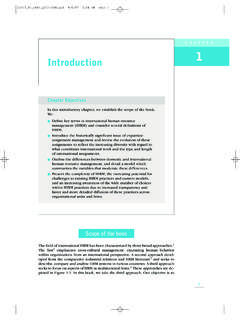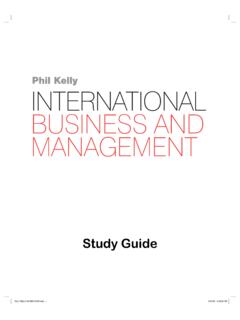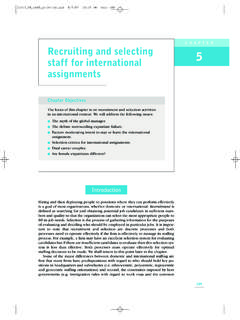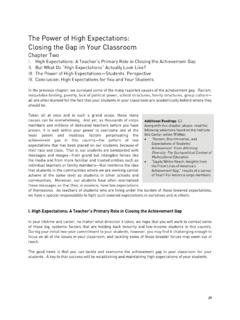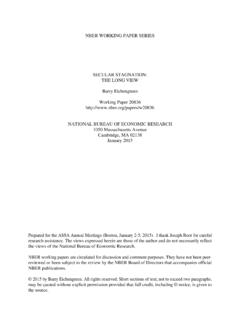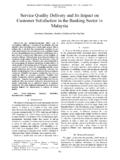Transcription of Further Review Q&As - Cengage EMEA
1 Further Review Q&As Chapter 1: Overview of Strategic Management 1) According to Mintzberg, strategists are like blind men who are feeling parts of an elephant and strategy formation is like the elephant thumping across the dessert;. the subject area is comprised of different views that make up that elephant. Describe the 10 schools of strategy, and explain their premise. - design school (a process of conception). - planning school (a formal process). - entrepreneurial school (a visionary process). - cognitive school (a mental process). - learning school (emergent process). - power school (a process of negotiation). - cultural school (a collective process). - environmental school (a reactive process). - configuration school (a process of transformation). 2) Explain the difference between strategy' and strategic management'. - The essence of strategy is about the courses of action necessary, or approach taken, for achieving the organization's core objectives and ultimately the overall purpose.
2 - Strategic management concerns the management of the organization's overall purpose, to ensure all the needs of the present are considered with those of the future. These may relate to all the six specific tasks of purpose, objectives, strategy, implementation, execution, and strategic control (POSIES, as summarised on page 309). - Hence, strategy is only one component (which operates at three levels . business, corporate and global) of strategic management. Strategy is also different from something that is tactical (hence Sun Tzu's famous line that all men can see the tactics whereby I conquer but what none can see is the strategy out of which great victory is evolved') or operational effectiveness (which Porter argues is important but is inferior to, and which cannot replace, real strategy). 3) Explain the levels of involvement in strategic management and the role of staff at each level. How does the strategy hierarchy facilitate this?
3 - The main responsibility of strategic management is predominantly at the top level. This is because senior management is most knowledgeable of the purpose of the organization and can therefore direct the whole organization to accomplish it. - However, everyone has some involvement in the doing of strategic management. The amount of personal involvement is reduced as we go down the levels of the organizational structure. Referring to figure , the amount of involvement in strategic management is shown by the pyramid whereby senior management (at the top) is most associated with strategic management and supervisors and operators are most involved in daily management but only a little strategic management. - The strategy hierarchy (illustrated in figure ) is an explication of the different levels of strategy and who are responsible for managing it at the different levels of hierarchy. The kind of strategy reflects the nature of the work undertaken by staff at the different levels of the hierarchy.
4 4) Explain the controversial debate in strategic management regarding how strategy can be formed or formulated, ie how emergent strategy is different from deliberate strategy. - Despite the more sophisticated contributions to the subject field on what makes up the strategy and the different schools, one of the key debates is if strategy should be formed over time or be formulated by senior management. Within this distinct division (between strategic planning and emergent strategy), the other separations such as Mintzberg's ten schools can also fit. - With formulation, the main premise is that senior management has the best knowledge of the overall strategy and is most appropriate for deciding on a strategy that the rest of the organization should follow. This view suggests that strategy should be consistent and specific to the organization, which is what gives it competitive advantage. - In contrast, there are the emergent strategists who suggest that there should not be one specific strategy (deliberate) and that the appropriate strategy should be formed over time (ie, emerge), taking into consideration patterns of past behaviour, thus enhancing the importance of the learning organization, where the importance lies in having good information flows.
5 This view is similar to the idea of James Brian Quinn on logical incrementalism. - The figure (figure ) by Peters and Waterman puts into context both deliberate and emergent strategy, illustrating how they become realized, or in one case how it is unrealized. - The Honda paper by Pascale provides a good source for discussion. 5) Outline the fundamental differences between outside-in and inside-out thinking about strategic management, and their influence on strategy. - Outside-in thinking about strategy concerns how the external environment, such as how the competitive position of the company, defines the way the organization is managed to sustain competitive advantage. An obvious example of this is Porter's view of competitive strategy, where the five forces that shape an industry must first be considered and then an appropriate strategy be chosen. - Inside-out thinking about strategy concerns the consideration of the internal resources of an organization as the key source of competitive advantage.
6 This is consistent with the resource-based view of strategy whereby competitive advantage is achieved through the particular integration of a firm's strategic resources. - In fact, both views are important, as for an organization both its external and internal environments must be assessed. The internal capabilities of a firm should be configured to meet the changing demands of the external environment. - Some examples of useful frameworks that consider either outside-in or inside- out thinking should be noted, as well as key issues in strategy, such as those given in figure Chapter 2: Purpose 1) Discuss the importance of purpose to an organization, and how that purpose may be regarded as synonymous to the purpose that underpins human existence. - The starting point to anything is its purpose, which is the same whether it is an organization or a human being. While there are numerous theories behind the existence of human beings on Earth, every individual has his/her own belief, and it is that belief that determines how s/he lives his/her life.
7 An organization exists for a long-term purpose, and making money is only one activity that facilitates the achievement of that long-term purpose, and does not constitute that purpose per se (otherwise it will have accomplished it already!). - To make a purpose' comprehensible to the organization, three distinct components are available to assist: vision, mission and values. The role of each of these is different, and quite often companies get it wrong. Even if these are not explicit, every organization still has them in the sense that they are implicit in the way it manages. Explicit statements also have the advantage of promoting to the public the strength of the company and Further acts as a marketing tool. - The way these influence the management of the organization is shown in figure , where vision affects the strategy, values affect the organizational culture, and mission affects the business model. 2) Who are the typical stakeholders of an organization, and how do they affect the purpose and management of it?
8 - The typical stakeholders of an organization include, but are not restricted to: lenders, customers, government, employees, owners, etc (as shown in figure ). Their influence upon the organization varies depending on the industry to which the organization belongs and the nature of that industry (particularly if it is either a high or low velocity industry). - Indeed, some organizations may not have some of those stakeholders at all and in some cases their presence is only implicit. - The key stakeholders are the customers, suppliers and employees. - The clarity and orientation of the purpose of an organization may be affected if one or more of the stakeholders have a strong influence over the way the organization works. For example, in the case of public services the safety or economic regulator has a control over the standards of services expected by the companies, and so the purpose of the organization should be aligned with their expectations.
9 Similarly, in industries of high competition, customers may be more demanding and so they may be able to sway the future direction, and thus influence even in a small degree the purpose, of the organization. 3) Is there always a perfect alignment between an organization's purpose and culture? - There may be a mismatch between the true intention of the organization's purpose and its culture mainly due to the lack of clarity of the former. - The purpose normally influences the culture of the organization as the purpose exists first and then people who are appointed to the position are then nurtured to the needs of that purpose. However, for reformed organizations, such as those which have become the outcome of non-organic growth (merger and acquisition activity), then the cultures may have existed first through a legacy of the merged companies and the newly established purpose may not be consistently or well aligned with them. - There are three levels of culture (artifacts, espoused values, and basic underlying assumptions) which must be managed differently by the manager concerned, and if these are not managed properly there is likely to be misalignment to the organizational purpose.
10 - To help managers think more seriously about managing the culture of the organization, the cultural web may be instrumental to that process (figure ). 4) Discuss the dangers of mismatch between corporate image and corporate identity. What strategies are possible for closing this difference gap? - Corporate image and corporate identity are different things: the former refers to what the organization is understood as to the stakeholders (as receivers), and the latter refers to the organization's self-image. - It is common for a mismatch between the two, particularly when the marketing efforts of the organization are not effective; in this case it is important that the organization is not prone to bad public impression. 5) How can the emergence of the importance of corporate social responsibility be seen as a threat to the purpose of an organization? - If the organization is an old one, there may be explicit mission statements that do not accord with the present expectation of corporate social responsibility.

